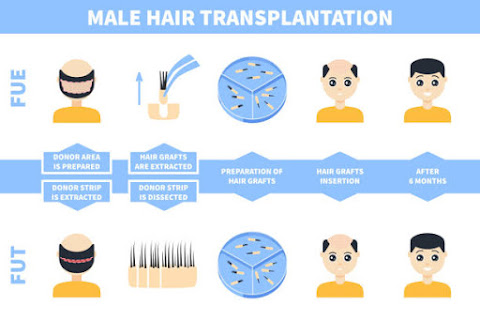Hair Restoration Services
Hair restoration services are the process of restoration of natural hair for bald persons. Baldness causes depression for most people who want to have a natural look. Looking beautiful is the desire and fundamental right of every individual and they can achieve this by having natural scalp hair. But, unfortunately, baldness is a hindrance to this basic right of the person. The baldness is common to both sexes but males suffer more than that female in baldness. The reason for this dominance in males is that it is a sex-limited trait. Man can be bald if he receives only one baldness gene either from his father or mother. However, a woman will only be bald if she receives both genes from her parents. These chances are usually very rare and occasionally happen when cases come out. The person can become bald after the age of 40 years or more. The other way by which a patient becomes bald is through the side effects of treatments like chemotherapy in cancer patients. The doctor does not advise these patients to undergo hair restoration services.
Hair restoration services available in the modern
era enable the man to gain their original look. These services include the
Follicular Unit Transplant (FUT), Follicular Unit Extraction (FUE), hybrid,
laser or Neograft transplant. These services differ from one another but the
ultimate consequences to get are the same. The physician first examines
thoroughly, whether the patient is eligible to undergo the transplant procedure
or not. He usually examines the donor site. If the donor site has enough hair,
then the physician allows the patient to undergo the procedure. In men, the
donor site can be the backside of the scalp or beard or chest hair. While in
females, the donor site can only be the backside of the scalp. The physician
then sets the patient on premedication surgery a few days before the treatment.
The doctor advises the patient to stop using alcohol and smoking. As alcohol
can cause a bleeding problem during surgery. Smoking is damaging to health and
also can block the supply of blood to the newly planted follicles. Use of any
blood thinner drug is avoided to save the risks of bleeding during surgery.
Many hair restoration options are successful. In the Follicular Unit
Transplant, the physician cuts the strip of skin. The place from which they
take the follicles is called the donor site. Then the surgeon seals this site
with the stitches and then implants the donor side strip to the recipient site.
There is one drawback of this technique as the incision is made so the linear
scar is left behind even after surgery. In the Follicular Unit Extraction, no
linear scar is left as no incision is made at the donor site. The surgeon
extracts the follicles and then separates these follicles. Then using microneedles,
the surgeon makes tiny or micro incisions at the recipient site. In these micro
holes, the surgeon then implants the separated follicles. In the hybrid type of
treatment, the physician then performs both previous treatments under a single
session of surgery. The strip is cut and follicles are separated and then implanted
at the recipient site using both techniques of FUT and FUE. As in the FUT, a
linear scar is obvious at the donor site.
In the robotic type of hair
restoration services, the robots perform the surgery. The ARTAS system of
robots detects the donor area with the help of cameras that gives them a
multidimensional view. The follicles are taken and using algorithms and
installed software; the follicles are separated automatically by robots. After
that, the robots then implant these automatically separated follicles in the
recipient area. In the robotic type of hair transplant service, the surgeon
uses an instrument called a wand to extract the follicles from the donor area
using the vacuum creation technique. Then these are implanted using the same
technique. The last technique has few side effects as it is the least invasive
and minimal manual procedure. The surgery can be completed in a single session.
However, sometimes the technique may take multiple sessions. In a single
session of surgery, usually, 2,000 to 3,000 grafts are moved from donor to the
recipient site. The cost of the treatment also varies depending on the surgeon,
location, number of follicles to be moved or session of surgeries in which the
treatment completes.

